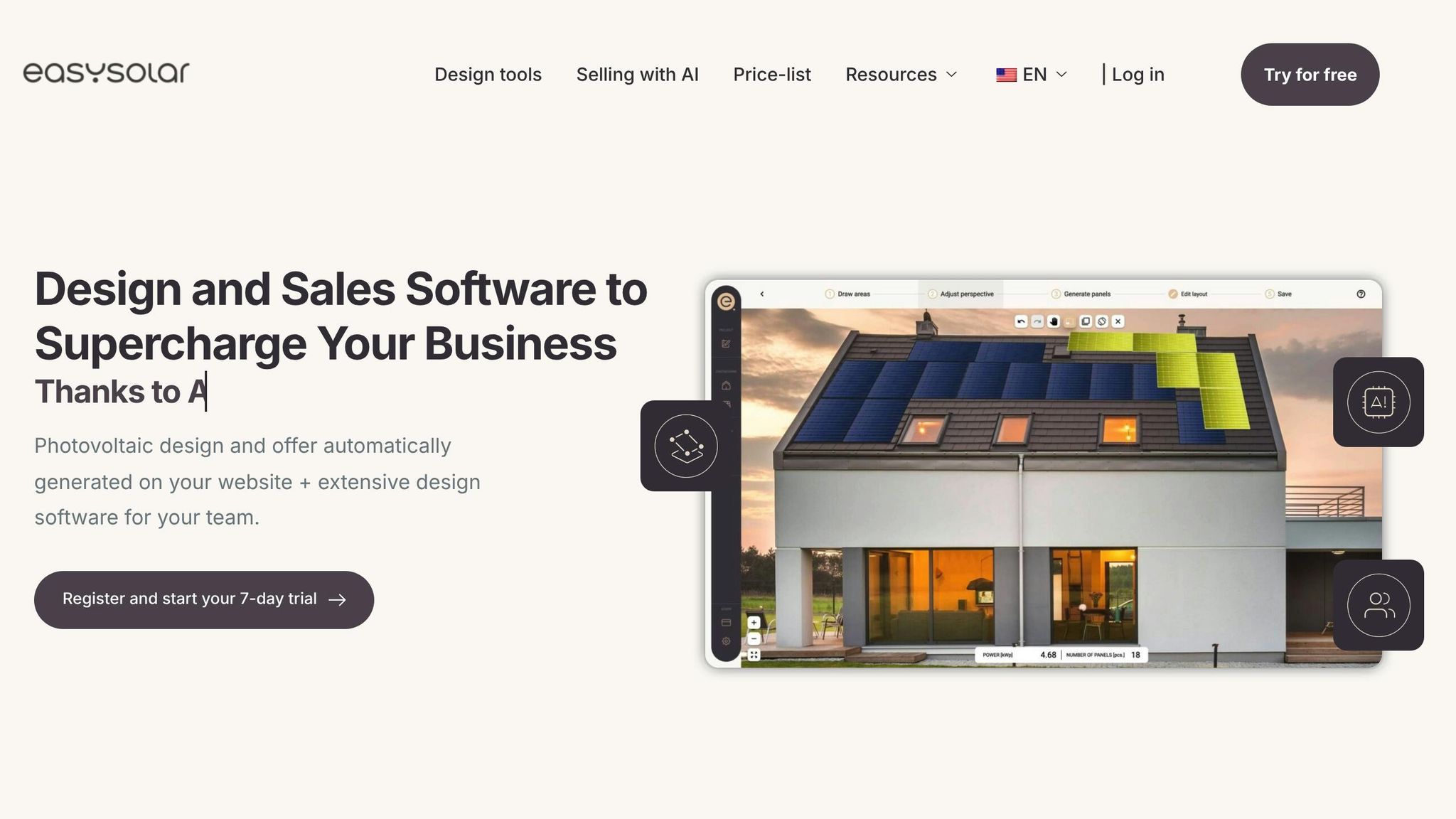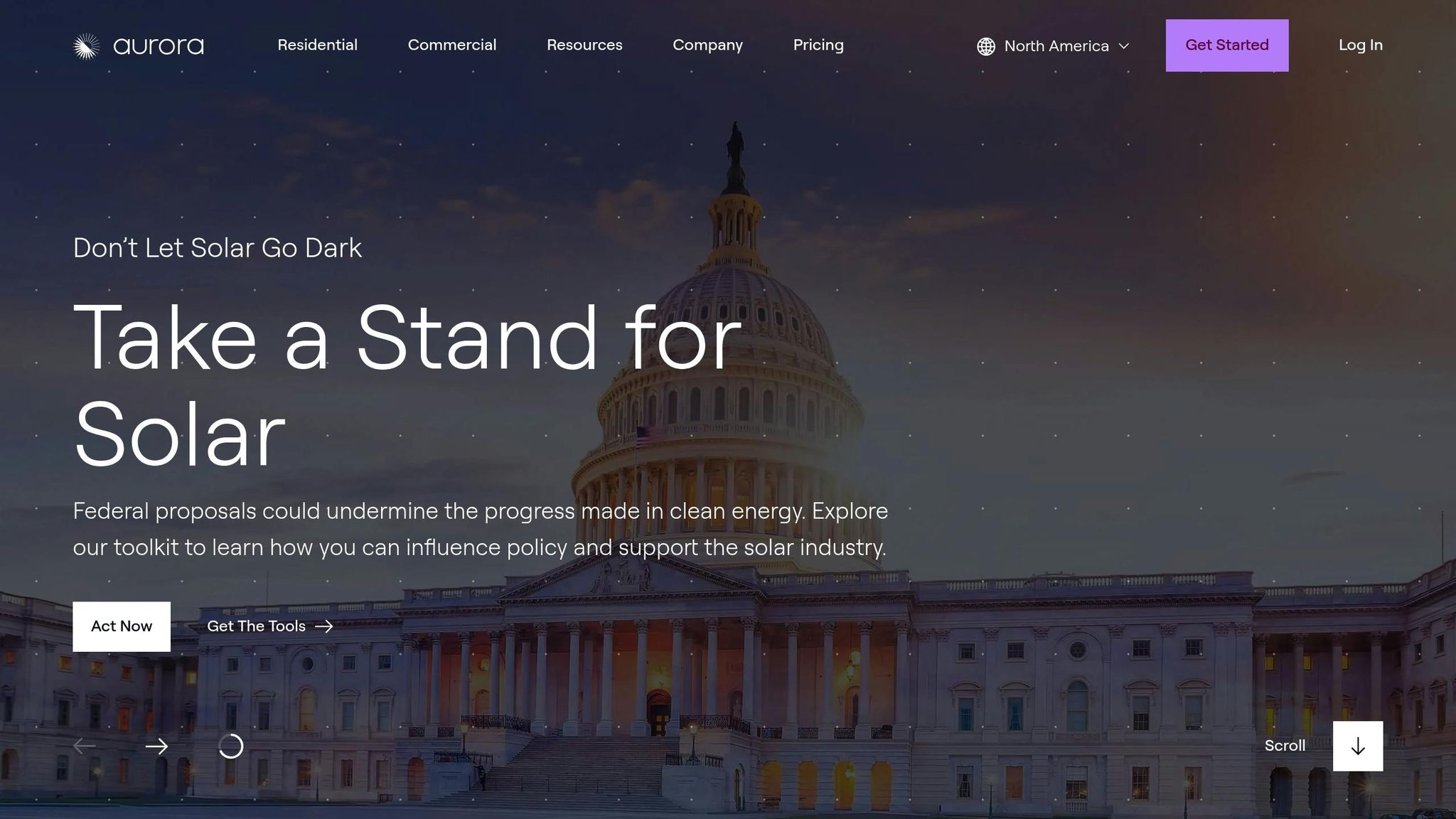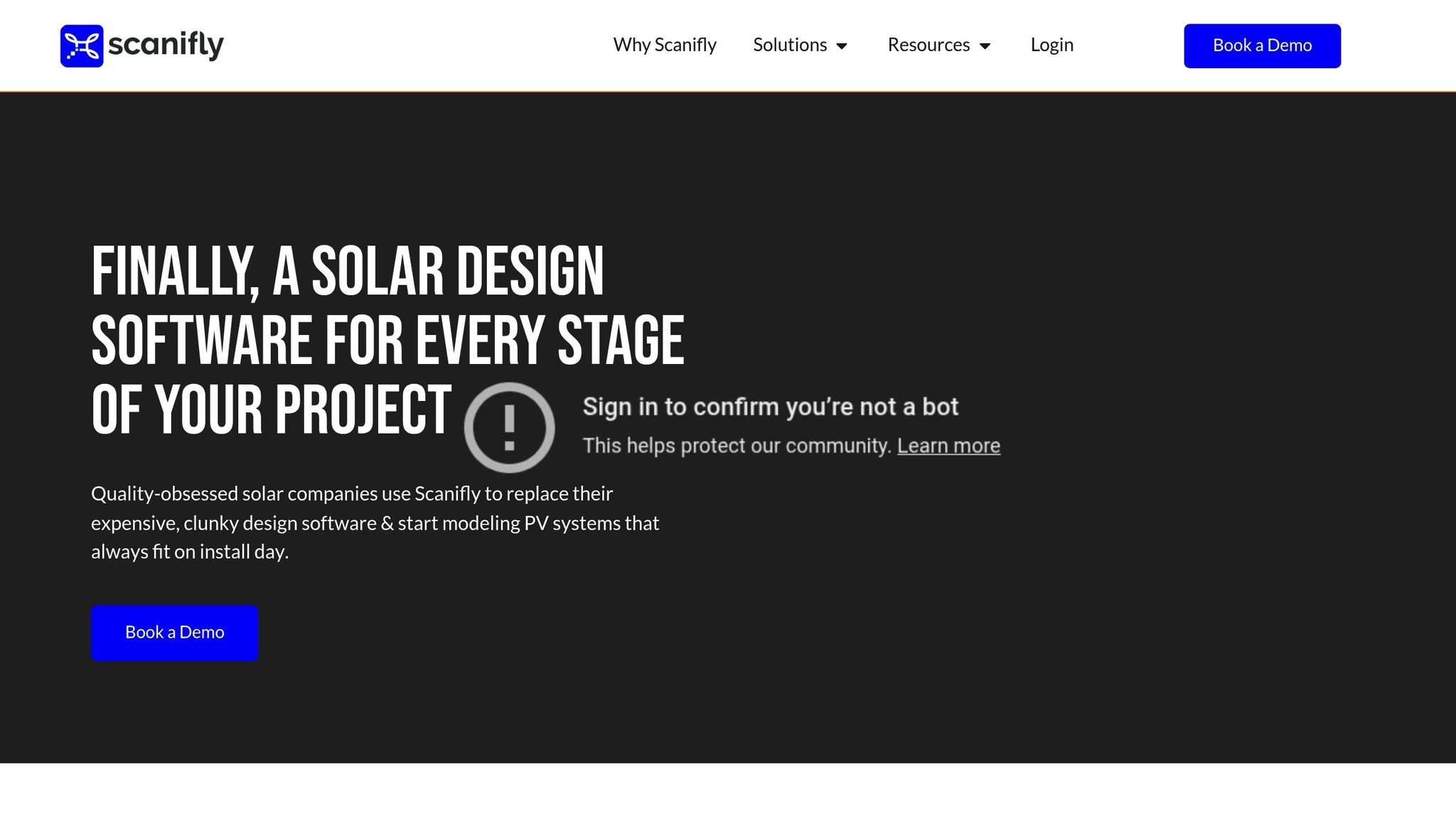Comparison of the best AI tools for photovoltaics in 2025.

Looking for the best AI tools for solar energy projects in 2025? Here’s a quick rundown of the top contenders:
- EasySolar: Simplifies solar design and sales with AI-powered layouts, real-time financial analysis, and built-in CRM. Affordable starting at $25/user/month.
- ToolX AI: Excels in predictive maintenance, hourly shading analysis, and financial modeling. Ideal for large-scale projects but requires significant training.
- SolarOpt AI: Focuses on drone-based precision layouts and adaptive energy optimization. High upfront costs but delivers up to 15% efficiency gains.
Quick Comparison
| Feature | EasySolar | ToolX AI | SolarOpt AI |
|---|---|---|---|
| Key Strength | All-in-one design-to-sales platform | Predictive maintenance & monitoring | Drone-based precision layouts |
| Layout Accuracy | AI-generated designs with shading maps | 8,760-hour shading analysis | Sub-5 cm drone imagery |
| Financial Modeling | Real-time ROI updates | 25% cost savings potential | Predictive analytics for ROI |
| CRM Integration | Built-in, seamless workflow | Integrates with existing CRMs | Customizable, API-enabled |
| Pricing | $25–$35/user/month | High computational costs | High upfront cost |
Each tool has unique strengths tailored to specific needs. Whether you prioritize affordability, advanced analytics, or precision layouts, there’s a solution for you.
1. EasySolar

EasySolar is a software platform designed to simplify the work of solar professionals, covering everything from system design to sales. By using artificial intelligence, it speeds up the creation of solar proposals, turning what used to be hours of work into a quick, five-minute process.
System Layout Precision
The platform’s AI tools automatically generate accurate photovoltaic system layouts. It uses drone imagery, maps, and sketches to create detailed visualizations that account for roof shapes, shading, and the best spots for panel placement. This reduces guesswork and limits expensive design changes during installation. Plus, these precise layouts feed directly into a powerful financial analysis system.
Built-In Financial Analysis
EasySolar includes tools to assess costs and profitability right within the design process. As system details are adjusted, the platform updates cost estimates instantly. This real-time feedback helps sales teams present clear ROI figures and financing options to potential customers. The combination of accurate designs and live financial updates makes project management smoother and more efficient.
CRM and Workflow Features
With an integrated CRM, EasySolar keeps projects and teams organized. From the first customer interaction to the final installation, the platform tracks every step, providing automated updates and notifications. Sales teams can view complete project histories, customer communications, and technical details all in one place. Collaboration tools like commenting, file sharing, and role-based access ensure everyone stays informed and connected.
Tailored for U.S. Compliance
EasySolar aligns with U.S. regulations by automatically creating compliant electrical diagrams. It also supports multi-currency options and lets users customize proposal templates to fit local market needs. These features help streamline project approvals and adapt to specific regional requirements.
The platform is available in two pricing tiers: Basic at $25 per user per month (minimum of two users) and Plus at $35 per user per month (minimum of ten users). The Plus plan includes advanced features like API integration and custom settlement terms, making it ideal for larger solar businesses with more complex needs.
2. ToolX AI

ToolX AI is a cutting-edge platform designed to simplify and enhance photovoltaic system design through the use of artificial intelligence. By automating complex calculations and optimizing performance at various project stages, it provides tools that make solar projects more efficient and accurate. Let’s dive into its standout features.
System Layout Accuracy
One of ToolX AI’s standout capabilities is its precise system layout design. Using aerial imagery and site-specific data, the platform generates detailed layouts tailored to each project. It performs an impressive hourly shading analysis for an entire year – that’s 8,760 simulations per project [1]. This level of detail ensures panel placement is optimized to account for seasonal shifts and daily sunlight patterns.
The AI-powered panel placement tool further refines designs by evaluating factors like roof geometry, structural limitations, and environmental conditions. By juggling these variables, ToolX AI ensures maximum energy output while keeping installations practical. This feature is particularly useful for complex roof designs or sites with significant shading challenges.
Financial Analysis Features
ToolX AI doesn’t stop at design – it also excels in financial planning. Its real-time financial modeling integrates seamlessly into the design process, transforming simulations and customer data into actionable insights. The platform identifies opportunities for up to 25% cost savings through AI-driven optimization, all while boosting solar panel efficiency [2]. This dual advantage allows solar businesses to stay competitive by offering attractive pricing without sacrificing profit margins. Plus, as designs change, the system updates cost estimates, financing options, and ROI projections automatically.
CRM and Workflow Integration
ToolX AI goes beyond technical design by streamlining customer relationship management and workflow processes. It integrates with existing CRM systems, enabling a smooth transition from initial lead capture to project completion. Features like lead nurturing, multi-channel messaging (voice, SMS, email), and automated follow-ups are all housed within the platform.
Additionally, ToolX AI tracks project histories and customer interactions, making it easier to manage team assignments and coordinate installation schedules. It even includes tools for online review management and social media scheduling, helping solar companies maintain their visibility and reputation while focusing on their core operations.
US-Specific Compliance
For solar professionals working in the United States, ToolX AI simplifies regulatory compliance. Its design algorithms incorporate local building codes, electrical standards, and permitting guidelines. The platform generates documentation that aligns with National Electrical Code (NEC) standards and local authority requirements, ensuring designs meet all necessary regulations.
On the financial side, ToolX AI supports U.S.-specific incentives, including federal tax credits, state programs, and utility rebates. By automating these compliance and financial considerations, the platform reduces administrative work, allowing solar professionals to focus on delivering high-quality projects from start to finish.
3. SolarOpt AI

SolarOpt AI is redefining photovoltaic system design by harnessing artificial intelligence to transform how solar projects are developed. By integrating drone technology with advanced AI algorithms, this platform delivers unmatched precision and efficiency for solar installations across the U.S.
System Layout Accuracy
One of the most impressive features of SolarOpt AI is its ability to capture incredibly detailed imagery – down to sub-5 cm resolution – using drones equipped with LiDAR and multi-spectral imaging. This technology generates highly accurate 3D point clouds, revealing even the smallest details like bare trees, power lines, and structural elements that could influence system performance. What’s more, its real-time shading analysis allows for thorough site evaluations without the need for rooftop access, keeping projects on track even during challenging weather conditions.
While traditional roof surveys can take an entire day, SolarOpt AI completes the job in just 20 minutes. This speed doesn’t come at the expense of accuracy, making it a game-changer for solar professionals looking to save time without compromising on precision.
This level of accuracy not only improves system layout but also directly enhances financial forecasting for solar projects.
Financial Analysis Features
SolarOpt AI goes beyond design by offering robust financial modeling tools. Using predictive analytics, the platform evaluates weather patterns and historical data to forecast energy production and project ROI. This data-driven approach helps solar businesses create stronger, more persuasive proposals for their clients.
The platform also includes AI-powered monitoring and adaptive control systems to ensure panels operate at peak efficiency, even under changing environmental conditions. By continuously optimizing energy output, SolarOpt AI maximizes both performance and long-term financial returns for solar installations.
The market potential for these advanced tools is enormous. The global Solar AI market is predicted to grow from $1,098 million in 2023 to $4,689 million by 2033, reflecting a 17.5% annual growth rate. In 2024, North America led the market with a 37.6% share, valued at $406.4 million. Machine learning dominates the sector with a 49.2% share, while energy management applications account for over 34.5%.
Beyond financial modeling, SolarOpt AI enhances project management with integrated CRM capabilities.
CRM and Workflow Integration
SolarOpt AI simplifies operations with a built-in CRM system that combines lead and project management, one-click communication, digital scheduling, and integrated e-signature and payment processing. This unified approach eliminates the need for juggling multiple software platforms, streamlining workflows for solar businesses.
The CRM is fully customizable, allowing businesses to configure pricing structures, profit margins, and payment methods to fit their needs. Companies can also white-label the platform, adding their own branding and content to maintain their corporate identity while benefiting from AI-powered tools.
In addition, SolarOpt AI acts as a central hub for project files and notes, offering customizable workflows and project tracking. For businesses already using other CRM systems, the platform provides API connectivity for seamless integration, ensuring it fits smoothly into existing processes.
US-Specific Compliance
Navigating the U.S. solar market’s complex regulations can be challenging, but SolarOpt AI simplifies the process. Its AI algorithms automatically incorporate federal, state, and local guidelines into system designs, ensuring compliance from the start. This proactive approach helps solar professionals avoid costly delays and regulatory issues.
The platform also supports proactive maintenance strategies to reduce unexpected downtimes and extend the life of solar assets. This is especially important for meeting warranty requirements and performance guarantees, both of which are critical in the U.S. solar industry.
sbb-itb-51876bd
Advantages and Disadvantages
Here’s a breakdown of the strengths and challenges of each tool:
| Tool | Advantages | Disadvantages |
|---|---|---|
| EasySolar | • Saves time with AI-powered automatic project generation • Supports multiple currencies, ideal for U.S. projects • Includes an integrated CRM for team collaboration and management • Offers fully customizable PDF proposals with branding options • API integration for smooth workflow connections • Affordable entry-level pricing |
• Requires a minimum of 2 users for Basic plans and 10 for Plus plans |
| ToolX AI | • Uses advanced machine learning for predictive maintenance • Real-time monitoring reduces downtime by up to 70% • Provides detailed data analytics for performance improvements |
• High computational costs for processing complex AI tasks • Demands significant investment in workforce training • Struggles with unpredictable weather conditions • May face cybersecurity risks in connected systems |
| SolarOpt AI | • Delivers optimized panel layouts, improving efficiency by 5%–15% | • High upfront costs for technology • Challenging to integrate with existing renewable energy systems • Limited in addressing physical issues like dust accumulation • Requires specialized training for effective use and data analysis |
Common Challenges Across Platforms
While these tools offer unique benefits, they also share some common hurdles that users should consider.
AI-driven optimization has been shown to cut costs by as much as 25%, but the initial investment can vary widely depending on the platform. Training and implementation are often significant obstacles, especially since the shortage of skilled professionals means companies must rely on ongoing technical support.
Data security is another pressing concern. Protecting sensitive project and customer data requires strong cybersecurity measures, such as encryption, multi-factor authentication, and advanced threat detection systems.
Scalability is also a key factor. EasySolar’s modular pricing makes it a good fit for growing teams, while SolarOpt AI may require more substantial infrastructure investments to scale effectively.
Integration capabilities differ as well. Platforms with strong CRM integrations tend to perform better in terms of ROI, but integrating these tools into complex systems – like projects that combine renewable and conventional energy sources – can still pose challenges.
Lastly, maintenance and support are vital for long-term success. AI-driven predictive maintenance can extend the lifespan of solar panels and improve returns, but the complexity of these systems often requires ongoing technical assistance to maximize their potential.
Final Thoughts
The future of AI in photovoltaic systems by 2025 highlights tailored solutions to address different solar industry challenges. Each tool brings its own set of strengths, designed to meet specific operational goals and business models.
EasySolar stands out as a complete design-to-sales platform, particularly suited for the US market. Its all-in-one approach simplifies workflows, making it an excellent choice for businesses focused on customer acquisition and regulatory compliance. ToolX AI, on the other hand, shines in predictive maintenance and real-time monitoring, making it ideal for large-scale operations where equipment reliability is critical. However, its high computational costs and steep training requirements may restrict its use to companies with significant technical resources. Meanwhile, SolarOpt AI specializes in layout optimization, offering up to 15% efficiency gains through advanced panel placement algorithms. While these efficiency improvements can boost energy output, the higher upfront costs and integration hurdles might deter smaller installers.
Choosing the right tool comes down to aligning it with your business needs and the regulatory landscape. For US solar professionals navigating complex market demands, EasySolar’s built-in CRM and compliance features can be a game-changer. These features help installers tackle challenges like net metering rules, tax credits, and permitting processes – key factors in a rapidly growing industry.
With projections estimating photovoltaic installations to hit 2 to 5 terawatts by 2030, staying adaptable to regulatory shifts and local market conditions is critical. Tools with strong financial modeling capabilities are especially important for demonstrating ROI to customers and stakeholders.
Reports indicate that AI-driven platforms can reduce survey times by as much as 70% and cut design times by 60–70%. The bottom line? Selecting the right platform – one that matches your operational scale, integration needs, and growth ambitions – can be the difference between staying ahead or falling behind in this fast-changing industry.
FAQs
How does EasySolar use AI to improve solar energy projects in 2025?
AI tools like EasySolar are reshaping solar energy projects in 2025 by simplifying system design and layout. This approach not only increases energy production by up to 30% but also reduces design costs by about 25%. These improvements help solar professionals create installations that are both efficient and cost-effective.
On top of that, EasySolar’s AI-driven capabilities, such as advanced forecasting and performance analytics, improve energy storage management and operational performance. By optimizing resource use and boosting energy output, it ensures solar projects run at their best while keeping expenses down. For solar businesses, EasySolar is quickly becoming a must-have tool.
What should I look for in an AI tool for designing photovoltaic systems?
When choosing an AI tool for photovoltaic system design in 2025, it’s essential to focus on its ability to deliver accurate energy output predictions and ensure precise system layout optimization. A tool that works effortlessly with satellite imagery and shading analysis can significantly enhance the performance of your solar installations.
You should also consider features like 3D modeling, financial analysis tools, and compatibility with drone inspections. These functionalities not only simplify workflows but also boost efficiency, helping you get the most value out of your solar projects.
How do AI-powered financial modeling tools improve the ROI of solar projects?
AI-driven financial modeling tools bring a new level of precision to solar projects by offering detailed insights and predictive analytics that simplify complex decision-making. These tools enable solar professionals to develop accurate financial forecasts, spot potential risks early, and allocate resources more efficiently.
With advanced data analysis, AI helps optimize system performance, cut down operational expenses, and boost long-term profitability. This empowers businesses to make informed investment choices and get the most out of their solar installations over the years.

